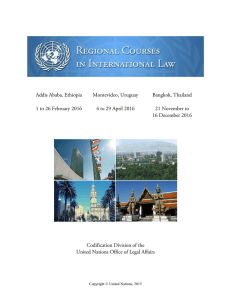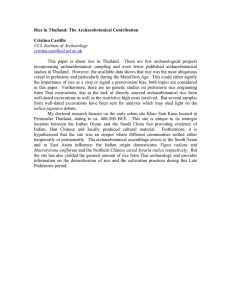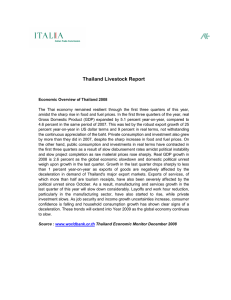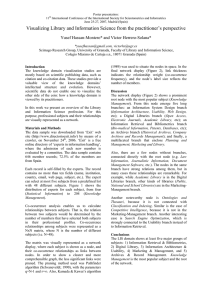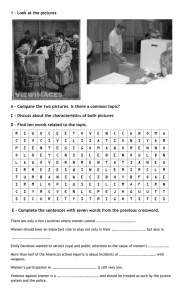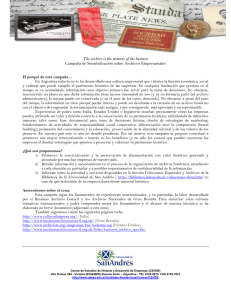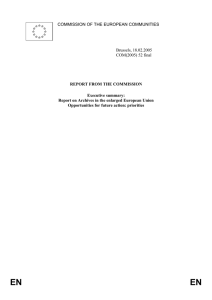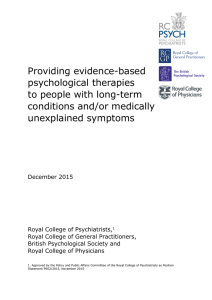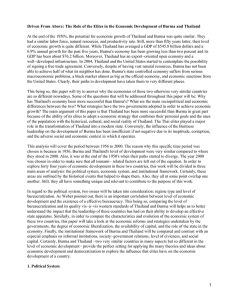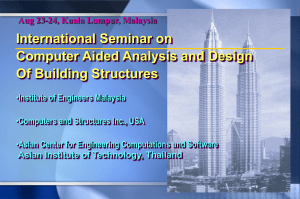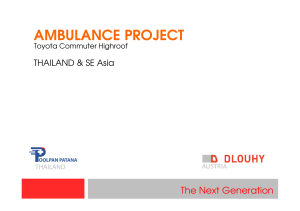Nomination Form
Anuncio
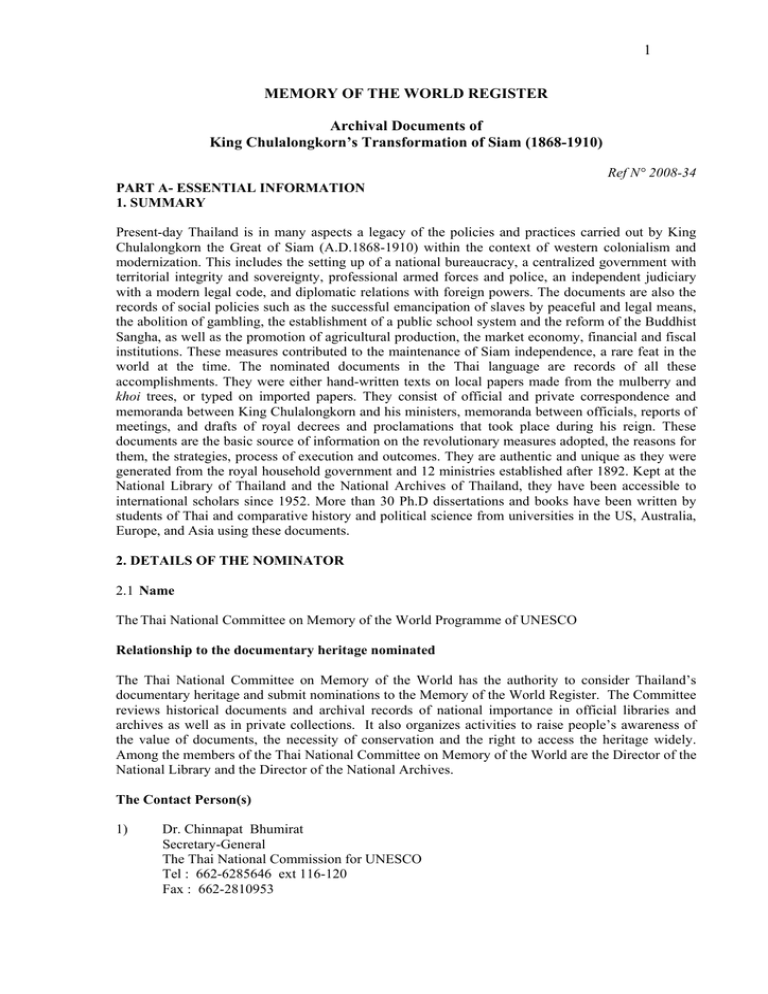
1 MEMORY OF THE WORLD REGISTER Archival Documents of King Chulalongkorn’s Transformation of Siam (1868-1910) Ref N° 2008-34 PART A- ESSENTIAL INFORMATION 1. SUMMARY Present-day Thailand is in many aspects a legacy of the policies and practices carried out by King Chulalongkorn the Great of Siam (A.D.1868-1910) within the context of western colonialism and modernization. This includes the setting up of a national bureaucracy, a centralized government with territorial integrity and sovereignty, professional armed forces and police, an independent judiciary with a modern legal code, and diplomatic relations with foreign powers. The documents are also the records of social policies such as the successful emancipation of slaves by peaceful and legal means, the abolition of gambling, the establishment of a public school system and the reform of the Buddhist Sangha, as well as the promotion of agricultural production, the market economy, financial and fiscal institutions. These measures contributed to the maintenance of Siam independence, a rare feat in the world at the time. The nominated documents in the Thai language are records of all these accomplishments. They were either hand-written texts on local papers made from the mulberry and khoi trees, or typed on imported papers. They consist of official and private correspondence and memoranda between King Chulalongkorn and his ministers, memoranda between officials, reports of meetings, and drafts of royal decrees and proclamations that took place during his reign. These documents are the basic source of information on the revolutionary measures adopted, the reasons for them, the strategies, process of execution and outcomes. They are authentic and unique as they were generated from the royal household government and 12 ministries established after 1892. Kept at the National Library of Thailand and the National Archives of Thailand, they have been accessible to international scholars since 1952. More than 30 Ph.D dissertations and books have been written by students of Thai and comparative history and political science from universities in the US, Australia, Europe, and Asia using these documents. 2. DETAILS OF THE NOMINATOR 2.1 Name The Thai National Committee on Memory of the World Programme of UNESCO Relationship to the documentary heritage nominated The Thai National Committee on Memory of the World has the authority to consider Thailand’s documentary heritage and submit nominations to the Memory of the World Register. The Committee reviews historical documents and archival records of national importance in official libraries and archives as well as in private collections. It also organizes activities to raise people’s awareness of the value of documents, the necessity of conservation and the right to access the heritage widely. Among the members of the Thai National Committee on Memory of the World are the Director of the National Library and the Director of the National Archives. The Contact Person(s) 1) Dr. Chinnapat Bhumirat Secretary-General The Thai National Commission for UNESCO Tel : 662-6285646 ext 116-120 Fax : 662-2810953 2 Email : [email protected] 2) Dr. Charuaypon Torranin Secretary-General, The Thai National Commission for UNESCO Ministry of Education, Rajadamnoen Nok Avenue Dusit, Bangkok 10300 Thailand Tel: (66)0-2628 5612 Fax: (66)0-2281 3490 E-mail: [email protected] 3) Prof. Khunying Maenmas Chavalit Chairperson of the Thai National Committee on Memory of the World Programme of UNESCO c/o SEAMEO SPAFA Library 81/1 Si-Ayutthaya Road, Sam-sen, Dusit Bangkok 10300 Tel: (66)0-2280 4022-9 Fax: (66)0-280 4030 E-mail: [email protected] 2.2 Contact details (include address, phone, fax, e-mail) same as above 3. IDENTITY AND DESCRIPTION OF THE DOCUMENTARY HERITAGE 3.1 Name and identification details of the items being nominated 3.1.1 Documents issued during the reign of King Chulalongkorn the Great (King Rama V), deposited at the National Archives of Thailand, dated B.E. 2411-B.E. 2543 (A.D. 1868-A.D. 1910) Custodian : The National Archives of Thailand Ta Wasukree, Tewes Samsen Road, Bangkok 10300, Thailand Tel. 662-281-6947 Fax. 662-281-5341 3.1.2 Documents issued during the reign of King Chulalongkorn the Great (King Rama V), written by hand, on hand-made paper, B.E. 2411-B.E. 2451 (A.D. 1868-A.D. 1908) Custodian : The National Library of Thailand Ta Wasukree, Tewes Samsen Road, Bangkok 10300, Thailand Tel. 662-281-0263 Fax. 662-281-7543 3.2 Description 3.2.1 Description and inventory The 2 collections consist of royal decrees, correspondence, proclamation, notes, royal orders, reports of the council meetings, narration of events etc. There are written by hand on hand-made paper, on paper sheets imported, and printed by machine. In the National Archives collection there are over 800,000 sheets or 765.8 linear feet. These are well treated and preserved. Some have been published, and digitized for wider dissemination. The Royal Gazette which was a set of printed sheets of paper was initiated by King Rama IV, King Chulalongkorn’s father. The intention was to inform Thai people about royal decrees, 3 proclamation. One of the most important laws is the abolition of slavery which was issued in B.E. 2448 (A.D. 1905). The National Archives’ documents pertaining to King Chulalongkorn’s reign were formerly kept at the Royal Secretariat Department and were transferred to the Archives in 1952 for public use. They are divided into 13 categories according to the new ministries set up by the King: Defence, Agriculture, Finance, Foreign Affairs, Capital City, Interior, Justice, Public Works, Royal Seals, Palace, Education, Royal Secretariat and including Miscellaneous. They are kept in files in cardboard boxes There is also a set of 367 bound volumes that cover such subjects as judicial verdicts, agreements, petitions and reports from the provinces. There are altogether nearly 50,000 subjects by entries. The National Library’s collection consist of “black books” made from khoi trees that were transferred from the Royal Palace to the Secretariat of the Cabinet and then to the National Library in 1939. There are divided into the original 26 categories which appear arbitrary. There are approximately 2,846 items in the National Library and 879.4 linear metres. Other topics cover:1) Establishment of modern education system, with the intention to provide knowledge to slaves who were freed, enable them to earn their living, and to enjoy intellectual developments; vocational education, such as agriculture, medicine were provided; new school textbooks were printed for wider distribution; English language learning was initiated, English teachers were hired; education for women was initiated under the leadership of Her Majesty Queen Sri Patcharindra; Teachers’ Training Colleges were established; scholarship to study abroad were provided; 2) Establishment of hospitals, and provision of public health services; establishment of Department of Medicine, Department of Public Health Services; Medical School; establishment of National Royal Red Cross Council; establishment of Nurse Training School; 3) Communication, and postal services, telegraph services, and telephone system. The Department of Postal Service was established; 4) Logistic systems; the establishment of train services, roads building; 5) Reformation of Government organizations systems from traditional 4 units into 12 ministries to ensure effectiveness of all activities concerned people’s happiness, justice, communication, health, education, diplomatic relations, national defense etc.; 6) Reformation of economic systems; effective taxation to ensure sufficient national revenue and in the same time establish the Ministry of Finance to handle national revenue and expenditure; 7) Establishment of electricity supply systems, and water supply; 8) Contribution to national literary expression. King Chulalongkorn was a fluent writer and a poet; his literary works include:(a) Lilit Nitra-Chakrite- a narrative poem based on one of the Arabian Night stories (b) Ngo Pa a drama based on a tragic tale of the Ngo Pa-Orang Asli ethnic group; (c) Klai Ban (Far Away from Home) letters to his daughter, Princess Nipha Nophadol, written during his months of visiting European countries, narrating about places, persons, and cultural events; (d) Phra Rajaphithee Sibsong Duen (Royal ceremonies to be undertaken, each month, through out the year, (e) Phra Raja Wichan – (Comments on historical events) 3.2.7 Selected Bibliography: 1. Prachoom Chomchai, Chulalongkorn the Great. Tokyo:the Centre for East Asian Cultural Studies. 1965 2. Tej Bunnag. The Provincial Administration of Siam 1892-1915. Kuala Lumpur: Oxford University Press, 1977 3. Terwiel, B. “Bondage and Slavery in Early Nineteenth Century Siam.” In Slavery, Bondage and Dependency in Southeast Asia, ed. Anthony Reid,118-137. Melbourne: University of Queensland Press. 1983. 4 4. Wichai Sewamat. The Abolition of Slavery in the Reign of King Chulalongkorn. (in Thai). Bangkok: NIDA Research Institute: 1966. 5. Wyatt, David K.The Politics of Reform in Thailand: Education in the Reign of King Chulalongkorn. Bangkok:Thai Wattana Panich, 1969. 6. Wyatt, David K. Thailand A Short History. New Haven and London: Yale University Press, 1984. 3.2.8 Referees 1. Associate Professor Wutdichai Moolsilpa Associate Fellow of the Royal Institute 200/523 Muang Thong Nivet 2/1 Patthanakan Road Pravet District, Bangkok 10250, Thailand Tel: (66) 0816439849 2. Maj. Gen.M.R.Suppawat Kasemsri Narathip Centre for Research in Social Science, National Library of Thailand, Na-Phra That Road, Bangkok 10200, Thailand. Tel: (66)0-2228 8786 4. JUSTIFICATION FOR INCLUSION/ASSESSMENT AGAINST CRIFERIA 4.1 Authenticity The authenticity of the collections of King Chulalongkorn documents is not in doubt, because they were produced in the Royal Palace which also housed the original National Library. 4.2 World Significance uniqueness and irreplacability. 4.2.1 World significance A historian at Cornell Univesrsity who used King Chulalongkorn papers extensively in the 1960’s, the late Professor David K Wyatt, concluded that the forty-two years of King Chulalongkorn’s reign marked “the definitive break between the old Siam and the new Thailand”. In the context of world history his actions deserve more studies. “Thailand is one of only a handful of Asian countries to have survived the most dangerous epoch of Western colonial expansion…The reasons for their respective survivals are dissimilar, as are the characteristics of each in transition. A feature of great significance for Thailand’s survival, however, was the fact the transformation of her society and government was accomplished largely through action from above, by leaders who were more than leaders; visionaries who were sensitive to the needs of the age and who forced change upon their nation and themselves directed and ordered its economic, social, and political development.” (Wyatt 1969, 376). The documents pertaining to King Chulalongkorn multi-faceted policies are the heart of the National Archives’ collection in Bangkok The collection of documents issued during King Chulalongkorn’s reign, from B.E. 2411 to B.E. 2454 (A.D1868-1910) are in no doubt of world significance, because they reflect the world trends of thought and the social, political economy and cultural development world wide. Thailand, during the first contact with European countries in the reign of King Rama III, (A.D. 1798-A.D.1851) under the shadow of colonialism, became aware of western advancement in the fields of education, economy, social, political and cultural development. For Thailand, the most significant contact with European 5 scholars took place when King Mongkut Rama IV, the father of King Chulaongkorn, utilized his knowledge in astronomy and mathematics to predict the total solar eclipse in B.E 2411 (A.D. 1868). Prince Chulalongkorn, the fourth son, was then 15 years, already fluent in English language, which was taught by an English lady. Almost after the solar eclipse, King Mongkut (Rama IV) passed away because of malaria sickness. Prince Chulalongkorn, a boy of 15 years old, became the ruler of Thailand with the help of the Regent. The young king was well aware of the world wide social, political and cultural development, made intention to make study visits to countries in Asia and Europe, in order to learn, to meet and to exchange opinions and experience with the ruler and outstanding officials of each country. He visited Singapore, Jawa (Indonesia) India and Burma (then). He visited European countries twice, in B.E.2440 (A.D 1897) and B.E. 2449 (A.D 1906). He was given glorious welcome wherever he went. The experience and knowledge gained from the visits, were utilized for the reformation and modernization the country, providing data on solving problems and establishment of modern society. . 4.2.2 Uniqueness The documents are unique because they are the original records of the deliberations and executions of important policies that transformed a traditional state and society into a modern one in the context of international relations, including such measures as the abolition of slavery through peaceful and legal means, while the same action in many countries caused civil wars. There are also:(a) Sets of documents about the gradual transferring of rights, responsibilities and the power of the monarch to the officials and the people at large; (b) Sets of documents pertaining to administrative rules and activities; (c) Sets of documents on establishing modern education systems – syllables, textbooks, teacher training, school premises, examination; vocational training etc. (e) Sets of manuscripts in King Chulalongkorn’s hand writing such as his letters written during his study visits abroad, the manuscript of his play writing “Ngua-Pa” etc. 4.2.3 Irreplaceability The collections are unique and significant at world level. They are intellectual outputs which indicate effective ways of solving serious problems at national and international levels, in particular when the country’s freedom was at stake. Their survival ensures the existence of a record of peaceful policies and practices in bringing about drastic changes and modernization in a country not under colonial rule. 4.3 Criteria of (a) time, (b) place, (c) people, (d) subject and theme, (e) form and style. 4.3.1 (a) Time The documents reflect the struggle for survival by a traditional state in face of modern arms and technology in the age of western imperialism. It show how “East met West” when compromises were made by both sides and a diplomatic etiquette played a part in ensuring friendly relations in the family of nations of the 19th century. 4.3.2 (b) Place Thailand (formerly Siam) is the only country in Southeast Asia that did not fall under colonial rule in the late 19th century. Thus, she had the rights to promulgate laws and carry out whatever policy she saw fit. She was free to initiate programmes for development in the areas of education, scientific advancement, social reformation, uphold human rights such as in the abolition of slavery, and to set up diplomatic relations with other countries of her choice. 4.3.3 (c) People 6 King Chulalongkorn was regarded by UNESCO in 2001 as an important figure in the history of the world. He was cited by UNESCO at its 31st General Conference on November 2, 2001, as the world’s outstanding person in the fields of education, culture, social science, social development, anthropology and communication. The 150th anniversary of his birth was celebrated by UNESCO in 2003. The abolition of slavery through legal and peaceful means is a unique undertaking that should be widely remembered as an act of a humanistic world leader. The documents also reveal the King’s interest in intellectual pursuits, in history, archaeology and the arts. He was a popular and well-known personality in European courts and appeared on French and English popular journals on several occasions. His use of the press in Siam to communicate with the public is also an innovative step that is now taken for granted in this information age. In recent years, nearly a century after his death he has been much revered in Thailand as a great and beloved king who laid the foundation for the country in all areas concerned. A personality cult has developed after the 1997 economic crisis when he became revered as a deity, in the tradition of ancestral worship. His pictures and small statues can be seen in most homes, offices and shops in Thailand today as people believe he will bring in good luck and protect them from harm. Every Tuesday, the day when the King was born, many people in Bangkok would gather at the equestrian statue in front of the old parliament building to offer him food and flowers and ask for his blessing. This spiritual bonding is a unique phenomenon, arising from the knowledge they gained from the study of history what kind of a person he was and how he cared for his subjects. 4.3.4 Subject and themes The transformation and modernization of Thailand is an epic in the modern world. Poetic monsters which threatened human life, such as dragons existed in the forms of colonialism, poverty, ignorance, etc, threatening life, prosperity and happiness of individuals, communities, and countries. King Chulalongkorn’s unflagging efforts in facing dangers wisely were recorded in the documents produced during his reign. These are worthy to be registered at world level because, in spite of all measures to set the world at peace, dangerous elements, caused by human beings and nature still exist. The documents cover many themes1) Respect of human right and freedom, abolition of slavery systems; 2) Promotion of education for all, regardless of social status; 3) Development of vocational education,- e.g. agriculture, medicine; 4) Land reform – irrigation system, land ownership for agricultural purposes; development of agricultural resources; 5) Replacement of the traditional administrative system by the establishment of 12 ministerial units; 6) Urban development, road building and urban beautification 7) Improving diplomatic relationship with countries in Asia and Europe; 8) Reforming of laws and court system; 9) Reforming and strengthening military systems for safe-guarding the country; 10) Modernization of economic systems and international monetary market; 11) Reformation of government system, transferring absolute monarchy power to the council of state; greater participation in national administration by officials and younger generation; 12) Promotion of studying western knowledge, culture, and scientific advancement. 4.3.5 Form and style It is well known among Thai scholars that documents of King Chulalongkorn’s reign are the most detailed and well written records of all in the Thai bureaucracy. The documents were written in simple style, straight forward, though certain terminologies were required for some legal documents such as the laws on slavery abolition, or new scientific terms such as electricity, telegraphy, and postal services. The documents in fact set the standards of official writing and Thai prose. 7 Many documents also contain personal emblems and heraldry used by Thai princes and the nobility of that period. 4.4 Issues of rarity, integrity, threat and management (a) Rarity There are other documents related to King Chulalongkorn’s activities in the archives in France and England that present other perspectives, but the documents nominated here are the indigenous records of an Asian state that was free to deliberate and carry out measures independently and judiciously. For that reason they are indeed very rare in the world and should be made known for further study widely. Those related to the abolition of slavery by peaceful means over several years are particularly valuable. (b) Integrity The collections of documents vary in term of completeness. Most topics are well covered by succeeding documents although it is know that there are more documents kept at some government ministries that have not been forwarded to the National Archives. There are also private papers kept by the Royal Secretariat Department that are not open the public. (c) Threat The collections are kept in temperature controlled rooms. Acid-free boxes are used for keeping documents in the National Archives. Less elaborate arrangements are made at the National Library although they are not under threats. (d) Management The National Archives of Thailand and the National Library of Thailand are national organizations which manage the documents in line with the international standard. There are standing plans to respond to different types of emergencies or disasters, such as theft and robbery, fire, riots, natural disaster, vandalism, accidents and terrorism. There are also postemergency recovery plans. 5. LEGAL INFORMATION 5.1 Owner (s) and custodian (s) of the documentary heritage (name (s) and contact details) a) Documentary heritage about King Chulalongkorn held at the National Library of Thailand. Miss Oraphin Limsakul Director Ta Wasukree, Tewes Samsen Road, Bangkok 10300, Thailand Tel. 662-281-0263 Fax. 662-281-7543 b) Documentary heritage held at the National Archives of Thailand Mrs. Sureerat Wongsangiam Director Ta Wasukree, Tewes Samsen Road, Bangkok 10300, Thailand Tel. 662-281-6947 Fax. 662-281-5341 8 5.3 Legal status. a) Category of ownership The original documents are public documents. Requests can be made to read and copy them at the National Archives and National Library of Thailand in Bangkok. b) Accessibility The National Library of Thailand and the National Archives of Thailand are accessible for consultation and research. Selected documents on important issues are printed in book form and distributed to libraries and governmental units concerned such as the Ministry of Education and Ministry of Foreign Affaires etc. The National Archives have made 558 microfilm copies of the original 5th Reign records and distributed each set to its 8 branches throughout the country. The original documents could be viewed if necessary, but readers are required to read the microfilmed copies. The reading room is open from 8.30 a.m. to 4.00 p.m. Monday to Friday and on 3 Saturdays each month. Similarly, the documents kept at the National Library are also available to researchers on weekdays from 9.00 a.m to 4.30 p.m, but they have not been microfilmed. About 1,800 researchers make use of the facilities at the National Archives a year. Since 1964 nearly 200 MA Theses in Thai language have been written using the documents of King Chulalongkorn’s reign in the National Archives. c) Copyright status. The documents are not subject to copyright. It is requested that the sources of the documents be mentioned when quoted in any publication. d) Responsible administration Already mention in 5.2 Custodians 6. MANGEMENT PLAN The overall management plan is under the management practice of the governmental organization. Special management plans are established for conservation and accessibility such as microfilming, digitization and web-sites. 7. COSULTATION 7.1 Provide details of consultation about this nomination with (a) the owner of the heritage; (b) the custodian; (c) your national or regional Memory of the World Committee (a) Owner – same as custodians (5.2) (b) Custodians – same as (5.2) (c) Relevant Regional or National Memory of the World Committee The Memory of the World Committee in Thailand comprise experts, scholars and officials from the state agencies concerned with the safeguarding of national documentary heritage. The present Committee was appointed by the Cabinet in 2005. It has held monthly meetings to consider possible candidates for nomination to the Memory of the World Register 9 PART B- SUBSIDIARY INFORMATION 8. ASSESSMENT OF RISK 8.1 All documents are not under any external threats apart from the decaying of the original 19th century paper imported from Europe. For this reason the contents are being transferred to microfilm and digital disks. ASSESSMENT OF PRESERVATION Controlling of room temperature, measures against humidity, heat, insects and human touch, use of acid-free paper, and washing acid out of the old paper are in line with the International Standards PARTC – LODGEMENT This nomination is lodged by Dr. Chinnapat Bhumirat Secretary-General The Thai National Commission for UNESCO 31 March 2008
